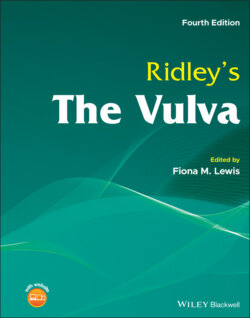Читать книгу Ridley's The Vulva - Группа авторов - Страница 136
Examination
ОглавлениеPhysical examination of the anogenital area should be conducted in a calm and sympathetic manner, with respect for the patient’s privacy. There should be a curtained area providing a space for undressing and dressing afterwards. Consent for examination should be sought, and this can be verbal but also implied by the patient cooperating with instructions. Clear explanation and reassurance should minimise any distress. Even if it is explained that there will be a female chaperone, some patients especially in certain religious cultures, will insist on a female doctor. This request should always be respected. If the patient has agreed to a student being present for history taking, it should not be assumed that the patient is willing to be examined in the presence of an observer, so a further request needs to be made before proceeding. The vast majority of patients readily agree to this if the importance of learning is explained.
It is known that most women find it helpful to have a chaperone for examination, but wide variation in policies and practice has been described previously [28,29]. It is now clearly recommended by many regulatory bodies that a chaperone must always be offered for all intimate examinations, which includes genital examination [30,31]. This is not only for the protection of the patient but also for the protection of the healthcare professional. From a practical perspective, an assistant is needed for examination anyway, and a good nurse can act as both chaperone and assistant. Another role for the chaperone is to ensure that there is continuing consent from the patient for examination. A family member should not act as a chaperone, as they are not impartial. In the rare instance where the patient refuses a chaperone, this must be clearly documented in the patient’s notes, and examination should not proceed without someone else being present if there are any concerns about the patient behaving in an inappropriate manner.
A parent may act as a chaperone when examining children, but it is still best practice to have an independent chaperone and many hospitals have a policy in relation to this. As with adults, a nurse can act as both chaperone and assistant.
Some practitioners use stirrups, but it is possible to examine the vulva adequately with the patient in the dorsal position with heels together and hips adducted, and then (for the perianal area) the left lateral position. It is vital to have good lighting, and ring lamps with central magnification are ideal. Other equipment is shown in Table 5.2. It is important to have all this readily available before examination is started.
The examination must be thorough and methodical, and include all areas of the vulva as well as the perineum and perianal area. A knowledge of the normal variations in appearance of the vulva is required in order to be able to note the abnormalities. Simple inspection will allow only the mons pubis, the labia majora, the margins of the labia minora, the perineal body, and the anus to be seen. Adequate exposure of the vulva requires the separation of the labia majora and minora. As several of the common vulval dermatoses alter the normal architecture, it is not only important to note abnormal additions such as inflammation or masses, but also to note important omissions, such as resorption of the labia minora or sealing of the clitoral hood. A specific order of examination helps, starting from the outside and working inwards that will include inguinal folds, mons pubis, labia majora, interlabial sulci, labia minora, vestibule, clitoris, hymen, posterior fourchette, perineum, perianal area, and gluteal cleft.
Table 5.2 Equipment needed for vulval examination.
| Gloves | Vinyl, non‐latex |
| Lighting | |
| Swabs | Bacterial |
| Viral | |
| Speculum | Small, medium, and large sizes |
| Lubricant | |
| Spatula | |
| Cotton tip swabs | |
| Gauze | |
| Mirror |
Examination of the vagina and cervix should be routine for those presenting with features suggestive of mucocutaneous diseases, HSIL, and vaginal discharge. Plastic speculums are most helpful as they allow any changes in the wall of the vagina to be easily seen. In some situations, the inguinal lymph glands will need to be palpated. Additional information and helpful diagnostic clues will be obtained from examination of the mouth, eyes, scalp, nails and other flexural sites, including the umbilicus (Figure 5.2).
